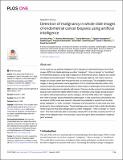Files in this item
Detection of malignancy in whole slide images of endometrial cancer biopsies using artificial intelligence
Item metadata
| dc.contributor.author | Fell, Christina | |
| dc.contributor.author | Mohammadi, Mahnaz | |
| dc.contributor.author | Morrison, David | |
| dc.contributor.author | Arandjelović, Ognjen | |
| dc.contributor.author | Syed, Sheeba | |
| dc.contributor.author | Konanahalli, Prakash | |
| dc.contributor.author | Bell, Sarah | |
| dc.contributor.author | Bryson, Gareth | |
| dc.contributor.author | Harrison, David J. | |
| dc.contributor.author | Harris-Birtill, David | |
| dc.date.accessioned | 2023-03-09T09:30:13Z | |
| dc.date.available | 2023-03-09T09:30:13Z | |
| dc.date.issued | 2023-03-08 | |
| dc.identifier | 283670379 | |
| dc.identifier | 0aaf97f2-145d-469a-99f0-924b27f21757 | |
| dc.identifier | 85149779177 | |
| dc.identifier.citation | Fell , C , Mohammadi , M , Morrison , D , Arandjelović , O , Syed , S , Konanahalli , P , Bell , S , Bryson , G , Harrison , D J & Harris-Birtill , D 2023 , ' Detection of malignancy in whole slide images of endometrial cancer biopsies using artificial intelligence ' , PLoS ONE , vol. 18 , no. 3 , e0282577 . https://doi.org/10.1371/journal.pone.0282577 | en |
| dc.identifier.issn | 1932-6203 | |
| dc.identifier.other | RIS: urn:9ABD387EA6644C9D411A696ECF2CD118 | |
| dc.identifier.other | ORCID: /0000-0001-9041-9988/work/130659588 | |
| dc.identifier.other | ORCID: /0000-0002-0740-3668/work/131123466 | |
| dc.identifier.other | ORCID: /0000-0001-5502-9773/work/136696664 | |
| dc.identifier.uri | https://hdl.handle.net/10023/27138 | |
| dc.description | Funding: For all authors this work is supported by the Industrial Centre for AI Research in digital Diagnostics (iCAIRD) which is funded by Innovate UK (https://www.ukri.org/councils/innovate-uk/) on behalf of UK Research and Innovation (UKRI) [project number: 104690], and in part by Chief Scientist Office, Scotland. (https://www.cso.scot.nhs.uk/). | en |
| dc.description.abstract | In this study we use artificial intelligence (AI) to categorise endometrial biopsy whole slide images (WSI) from digital pathology as either “malignant”, “other or benign” or “insufficient”. An endometrial biopsy is a key step in diagnosis of endometrial cancer, biopsies are viewed and diagnosed by pathologists. Pathology is increasingly digitised, with slides viewed as images on screens rather than through the lens of a microscope. The availability of these images is driving automation via the application of AI. A model that classifies slides in the manner proposed would allow prioritisation of these slides for pathologist review and hence reduce time to diagnosis for patients with cancer. Previous studies using AI on endometrial biopsies have examined slightly different tasks, for example using images alongside genomic data to differentiate between cancer subtypes. We took 2909 slides with “malignant” and “other or benign” areas annotated by pathologists. A fully supervised convolutional neural network (CNN) model was trained to calculate the probability of a patch from the slide being “malignant” or “other or benign”. Heatmaps of all the patches on each slide were then produced to show malignant areas. These heatmaps were used to train a slide classification model to give the final slide categorisation as either “malignant”, “other or benign” or “insufficient”. The final model was able to accurately classify 90% of all slides correctly and 97% of slides in the malignant class; this accuracy is good enough to allow prioritisation of pathologists’ workload. | |
| dc.format.extent | 28 | |
| dc.format.extent | 6943692 | |
| dc.language.iso | eng | |
| dc.relation.ispartof | PLoS ONE | en |
| dc.subject | RC0254 Neoplasms. Tumors. Oncology (including Cancer) | en |
| dc.subject | QA75 Electronic computers. Computer science | en |
| dc.subject | E-DAS | en |
| dc.subject | SDG 3 - Good Health and Well-being | en |
| dc.subject | MCC | en |
| dc.subject.lcc | RC0254 | en |
| dc.subject.lcc | QA75 | en |
| dc.title | Detection of malignancy in whole slide images of endometrial cancer biopsies using artificial intelligence | en |
| dc.type | Journal article | en |
| dc.contributor.sponsor | Innovate UK | en |
| dc.contributor.institution | University of St Andrews. School of Medicine | en |
| dc.contributor.institution | University of St Andrews. School of Computer Science | en |
| dc.contributor.institution | University of St Andrews. Sir James Mackenzie Institute for Early Diagnosis | en |
| dc.contributor.institution | University of St Andrews. Cellular Medicine Division | en |
| dc.contributor.institution | University of St Andrews. Centre for Research into Ecological & Environmental Modelling | en |
| dc.identifier.doi | 10.1371/journal.pone.0282577 | |
| dc.description.status | Peer reviewed | en |
| dc.identifier.grantnumber | TS/S013121/1 | en |
This item appears in the following Collection(s)
Items in the St Andrews Research Repository are protected by copyright, with all rights reserved, unless otherwise indicated.

